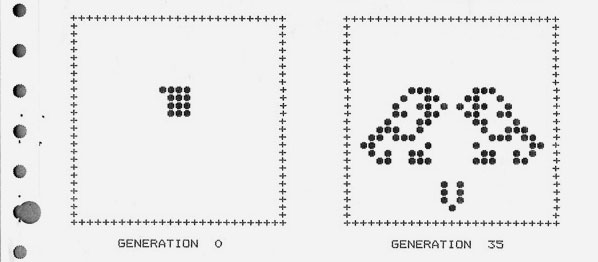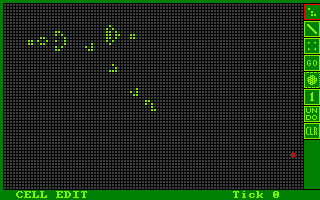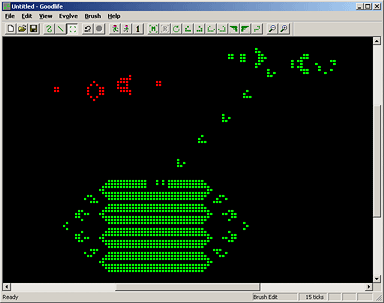 |
|
|
|

|

|
It’s a wonderful Life! [Freeware at the bottom] |
|
|
|
|
Isn't Life wonderful?
I'm not talking about Real Life, which is fine but surely leaves room for improvement. I'm talking about Life, the game-yet-more-than-a-game. GOL: Conway's Game of Life.
Like many hackers and geeks of my generation, I was
introduced to this game in 1970 by that masterful mathematical storyteller,
Martin Gardner. In his Scientific American column he showed us
a glimpse
of a wondrous new dimension of evolving, moving,
transforming “organisms” that emerge from the few simple rules of
this cellular automaton. Another thing that evolved in front of my
eyes was the depth of knowledge about Life: the original article
marveled at the simple Glider; by the time Gardner published the
book “Wheels, Life, and Other Mathematical Amusements” the
enthusiastic recreational math community had discovered the “Glider
gun”, which created a stream of gliders, and the humongous
“Breeder”, which created glider guns. Unfortunately, at the time all
I could see of the Breeder was a picture in a book; its huge size precluded any
hope that I would be able to witness it in motion (or so I thought). |
|
|
|

|
|
|
|
Whenever I learned a new programming language I'd do a GOL program almost first thing after the mandatory “Hello, world”. When Home Computing entered my life I wrote a nice implementation in Forth for the Commodore 64; but my best version was done soon afterward, in C, for the marvelous Amiga. A screenshot of that version is shown to the right (for some reason I liked to do my Amiga programs in a shades-of-green color scheme). |

|
|
|
|
Meanwhile the mathematicians forged ahead.
New and ever larger patterns were being discovered and investigated;
faster and better programs were making it into the public domain;
and most fascinating of all, philosophical insights were conjectured
and proven. Someone proved that you can do a Turing Machine in Life
-- and someone has gone and done it (see
here).
Someone has even proved that you can do a Von Neumann
self-replicating organism, though this huge task has yet to be
realized. And people are developing a variety of fascinating patterns with
fascinating behaviors, such as pseudo-random number generators and
computer logic elements... The best read I’ve found on the subject is William Poundstone’s “The recursive universe”, a must-read if you’re as fascinated by all this as I am. There are many Life programs and resources out there; the best program I have for the PC is Life32, which is powerful enough to handle the Breeder and similar huge patterns. The patterns themselves are also available online, for example here. |
|
|
|
As for the fruit of my own humble labors: you’re welcome to the Windows version of my Amiga program, Goodlife. It is far smaller and much slower than Life32 and similar high-end programs, and would hardly be of use to a professional, but for the beginner it does have the advantage of a very friendly and pleasing user interface, inspired in fact by that of the legendary DeluxePaint on the Amiga (remember DeluxePaint?unforgettable...) |

|
|
|
|
So, if you want to try it out, here it is. No installation necessary... just unzip the files and run the executable. Goodlife may be freely used and distributed on a non-commercial basis subject to the conditions listed in its included documentation file.
Enjoy! |
|
|
|
|
|
|
|
Home | HOC | Fractals | Miscellany | About | Contact Copyright © 2007 N. Zeldes. All rights reserved. |
|